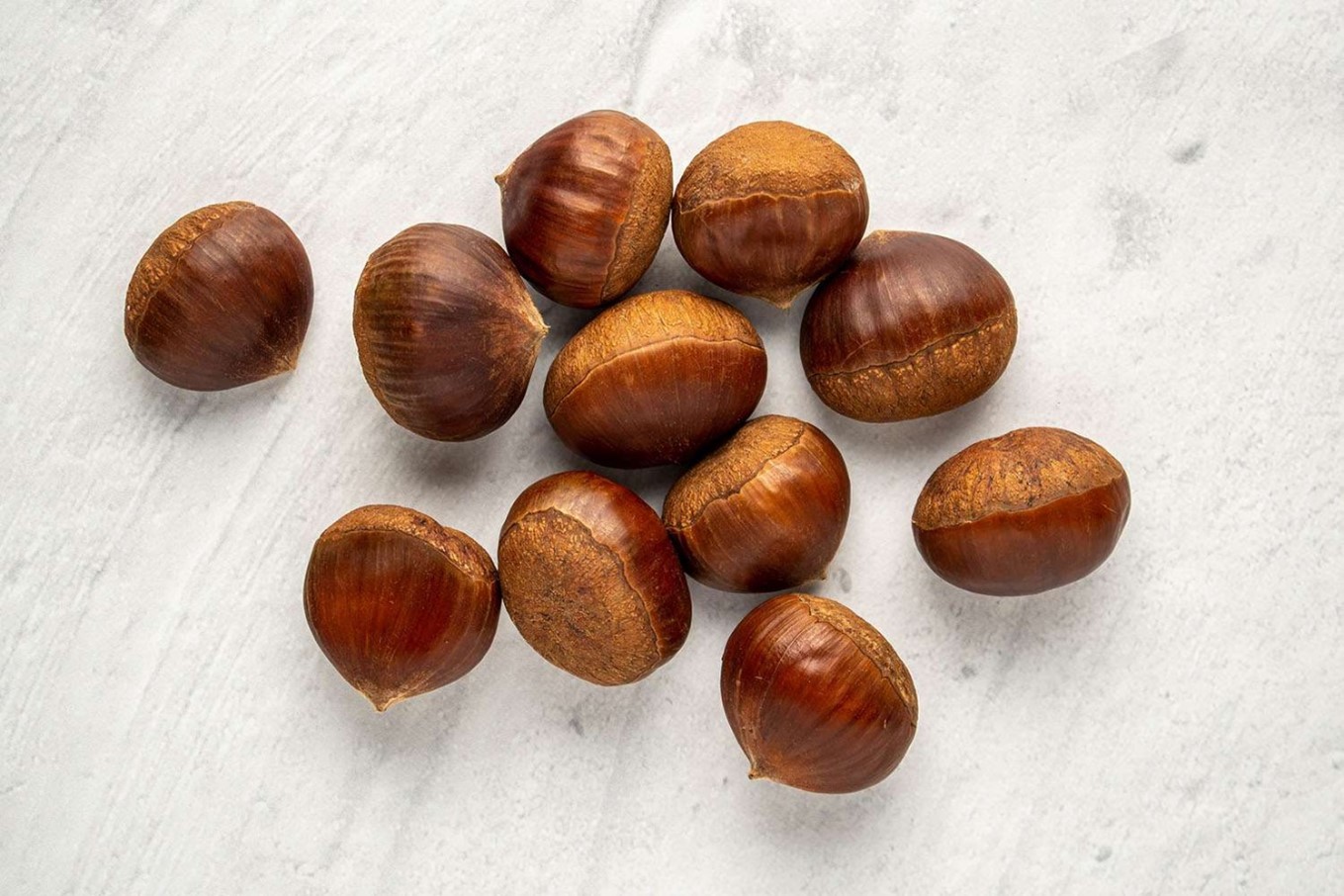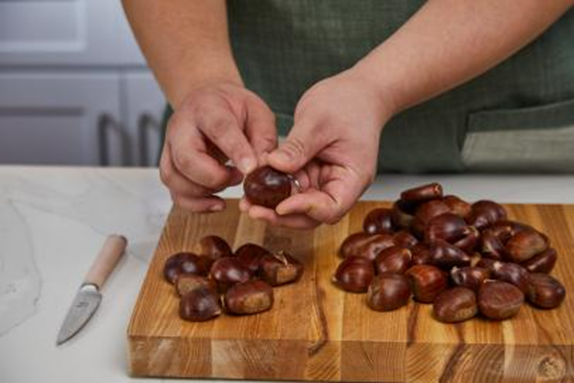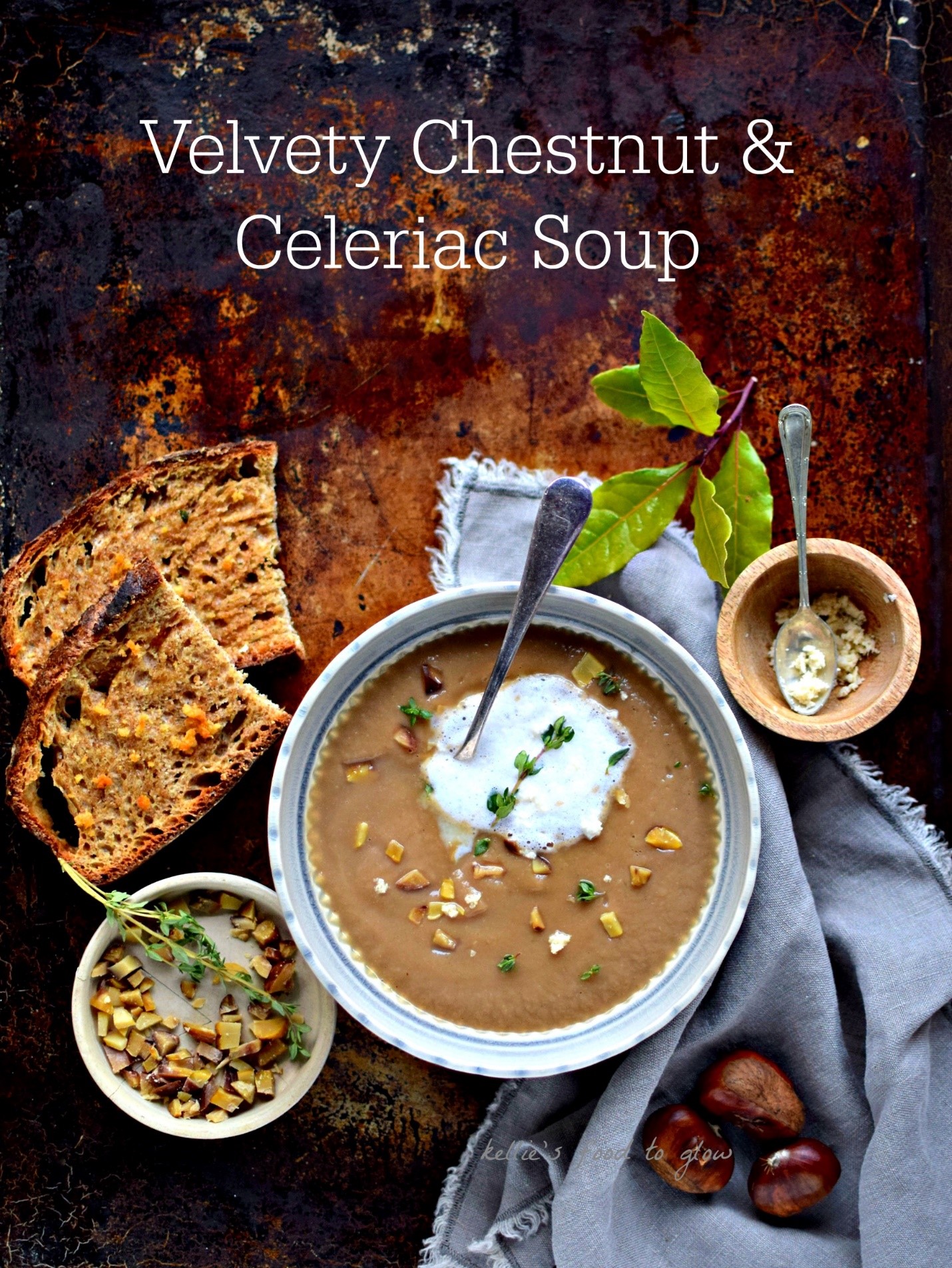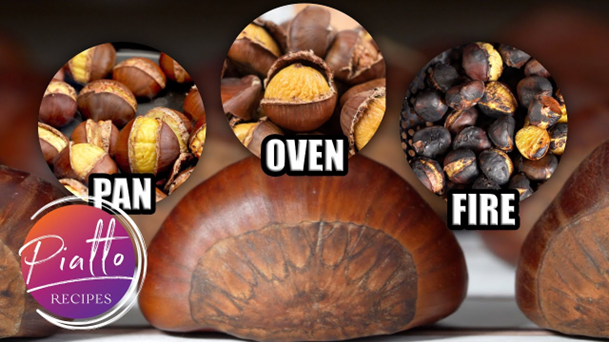Roasted CHESTNUTS—Why All the Accolades?
Because of their health benefits, for one. Although chestnuts have less protein than other nuts, they also have less fat. They’re mostly carbohydrates. Because carbohydrates have fewer calories per gram than fat—4 calories vs. 9 calories—chestnuts are far lower in calories than other nuts. A half-cup of chestnuts has 175 calories compared with 414 calories for a half-cup of almonds.

And their nutrition profile is strong. In just half a cup of chestnuts, you get decent amounts of two important minerals—manganese (vital for cell function and bone health) and copper (crucial to the formation of red blood cells). Chestnuts also supply vitamin C, folate, and potassium. Top all this off with their respectable fiber count—3.6 grams (13 percent of the amount needed daily).
This lovely nut is also rich in antioxidants, especially ellagic acid, which is also found in berries, pomegranates, pecans, and walnuts. Ellagic acid is a polyphenol, a compound that helps control inflammation, the risks of type 2 diabetes and nonalcoholic fatty liver disease, and it helps control cholesterol levels.

Then there’s their versatility. They can be used in sweet and savory applications, or just eaten on their own. You can use them just as you would any other nut. They have a nutty, sweet flavor, and a slightly mealy, crumbly texture.
Chestnuts add heartiness to recipes. They’re perfect for bread-based stuffing because their richness complements herbs and vegetables typically used. They add sparkle to roasted Brussels sprouts and other vegetable side dishes. Chopped roasted chestnuts make a standout topping for Greek yogurt, paired with a drizzle of honey and a few dried cherries. And they’ll add creaminess to soups made with mushrooms, squash, parsnips, celeriac, and cauliflower.

There are just a couple things to know if you want to start using chestnuts. They need refrigeration because they’re very perishable. And most chefs recommend cooking them before eating. This makes the starch more digestible.
For snacks and salads, you want them dry, so roasting is best. To roast, use a knife to carefully score an “X” on both the flat and domed side of the chestnut. While you can roast them over an open fire (tradition, tradition!) or in a pan on the stovetop, it’s a lot easier in an oven or toaster oven. Place on a baking sheet and roast for 15 minutes at 375° F. Turn and roast for an additional 10 minutes.

Whatever method you use (the open fire or oven), the nuts are ready when the X’s pop open, revealing the nut flesh. Remove the hard outer shell as well as the thin inner membrane before eating or using in a recipe.
You can also find roasted chestnuts online and in most grocery stores, ready for use. Whether you buy them fresh or packaged, they’re worth the purchase and the effort to learn to use them.
If you’re interested, here’s a recipe for a delicious soup to get you started. This recipe was developed by Del Sroufe (a chef for www.nutritionstudies.org). One taste and I could see why roasted chestnuts are worth all the accolades!

2 large shallots diced small
1 teaspoon fresh rosemary minced
2 teaspoons fresh thyme minced
1/2 teaspoon nutmeg
1 head (large) cauliflower cut into florets (about 6 cups)
9 ounces roasted chestnuts roughly chopped (about 1½ cups)
1 1/2 cups unsweetened, unflavored plant milk
1 cup low-sodium vegetable broth
2 tablespoons nutritional yeast
sea salt to taste
black pepper to taste
Directions:
Add Recipe to Cook'n
blog comments powered by Disqus

And their nutrition profile is strong. In just half a cup of chestnuts, you get decent amounts of two important minerals—manganese (vital for cell function and bone health) and copper (crucial to the formation of red blood cells). Chestnuts also supply vitamin C, folate, and potassium. Top all this off with their respectable fiber count—3.6 grams (13 percent of the amount needed daily).
This lovely nut is also rich in antioxidants, especially ellagic acid, which is also found in berries, pomegranates, pecans, and walnuts. Ellagic acid is a polyphenol, a compound that helps control inflammation, the risks of type 2 diabetes and nonalcoholic fatty liver disease, and it helps control cholesterol levels.

Then there’s their versatility. They can be used in sweet and savory applications, or just eaten on their own. You can use them just as you would any other nut. They have a nutty, sweet flavor, and a slightly mealy, crumbly texture.
Chestnuts add heartiness to recipes. They’re perfect for bread-based stuffing because their richness complements herbs and vegetables typically used. They add sparkle to roasted Brussels sprouts and other vegetable side dishes. Chopped roasted chestnuts make a standout topping for Greek yogurt, paired with a drizzle of honey and a few dried cherries. And they’ll add creaminess to soups made with mushrooms, squash, parsnips, celeriac, and cauliflower.

There are just a couple things to know if you want to start using chestnuts. They need refrigeration because they’re very perishable. And most chefs recommend cooking them before eating. This makes the starch more digestible.
For snacks and salads, you want them dry, so roasting is best. To roast, use a knife to carefully score an “X” on both the flat and domed side of the chestnut. While you can roast them over an open fire (tradition, tradition!) or in a pan on the stovetop, it’s a lot easier in an oven or toaster oven. Place on a baking sheet and roast for 15 minutes at 375° F. Turn and roast for an additional 10 minutes.

Whatever method you use (the open fire or oven), the nuts are ready when the X’s pop open, revealing the nut flesh. Remove the hard outer shell as well as the thin inner membrane before eating or using in a recipe.
You can also find roasted chestnuts online and in most grocery stores, ready for use. Whether you buy them fresh or packaged, they’re worth the purchase and the effort to learn to use them.
If you’re interested, here’s a recipe for a delicious soup to get you started. This recipe was developed by Del Sroufe (a chef for www.nutritionstudies.org). One taste and I could see why roasted chestnuts are worth all the accolades!

Cream of Cauliflower and Roasted Chestnut Soup
Serving size: 6
Ingredients:
2 large shallots diced small
1 teaspoon fresh rosemary minced
2 teaspoons fresh thyme minced
1/2 teaspoon nutmeg
1 head (large) cauliflower cut into florets (about 6 cups)
9 ounces roasted chestnuts roughly chopped (about 1½ cups)
1 1/2 cups unsweetened, unflavored plant milk
1 cup low-sodium vegetable broth
2 tablespoons nutritional yeast
sea salt to taste
black pepper to taste
Directions:
1. Heat a large pot over medium heat, then add the shallots to the pan and saute? for 5
minutes until they start to brown and turn translucent. Add water 1 to 2 tablespoons
at a time, as needed, to keep the vegetables from sticking to the pan.
2. Add the rosemary, thyme, and nutmeg, and cook for another minute.
3. Add the cauliflower, chestnuts, plant milk, vegetable broth, and nutritional yeast.
4. Cover the pot and simmer until the cauliflower is tender, about 15 minutes.
5. Remove the soup from the stove and pure?e it in batches using a blender.
6. Return the puréed soup to the pan and season with salt and pepper.
minutes until they start to brown and turn translucent. Add water 1 to 2 tablespoons
at a time, as needed, to keep the vegetables from sticking to the pan.
2. Add the rosemary, thyme, and nutmeg, and cook for another minute.
3. Add the cauliflower, chestnuts, plant milk, vegetable broth, and nutritional yeast.
4. Cover the pot and simmer until the cauliflower is tender, about 15 minutes.
5. Remove the soup from the stove and pure?e it in batches using a blender.
6. Return the puréed soup to the pan and season with salt and pepper.
Recipe formatted with the Cook'n Recipe Software from DVO Enterprises.
 Alice Osborne
Alice Osborne
Weekly Newsletter Contributor since 2006
Email the author! alice@dvo.com
Sources:
- www.thespruceeats.com
- www.foodnetwork.com
- www.foodtoglow.com
- www.piattorecipes.com
- www.cnskitchen.nutritionstudies.org
